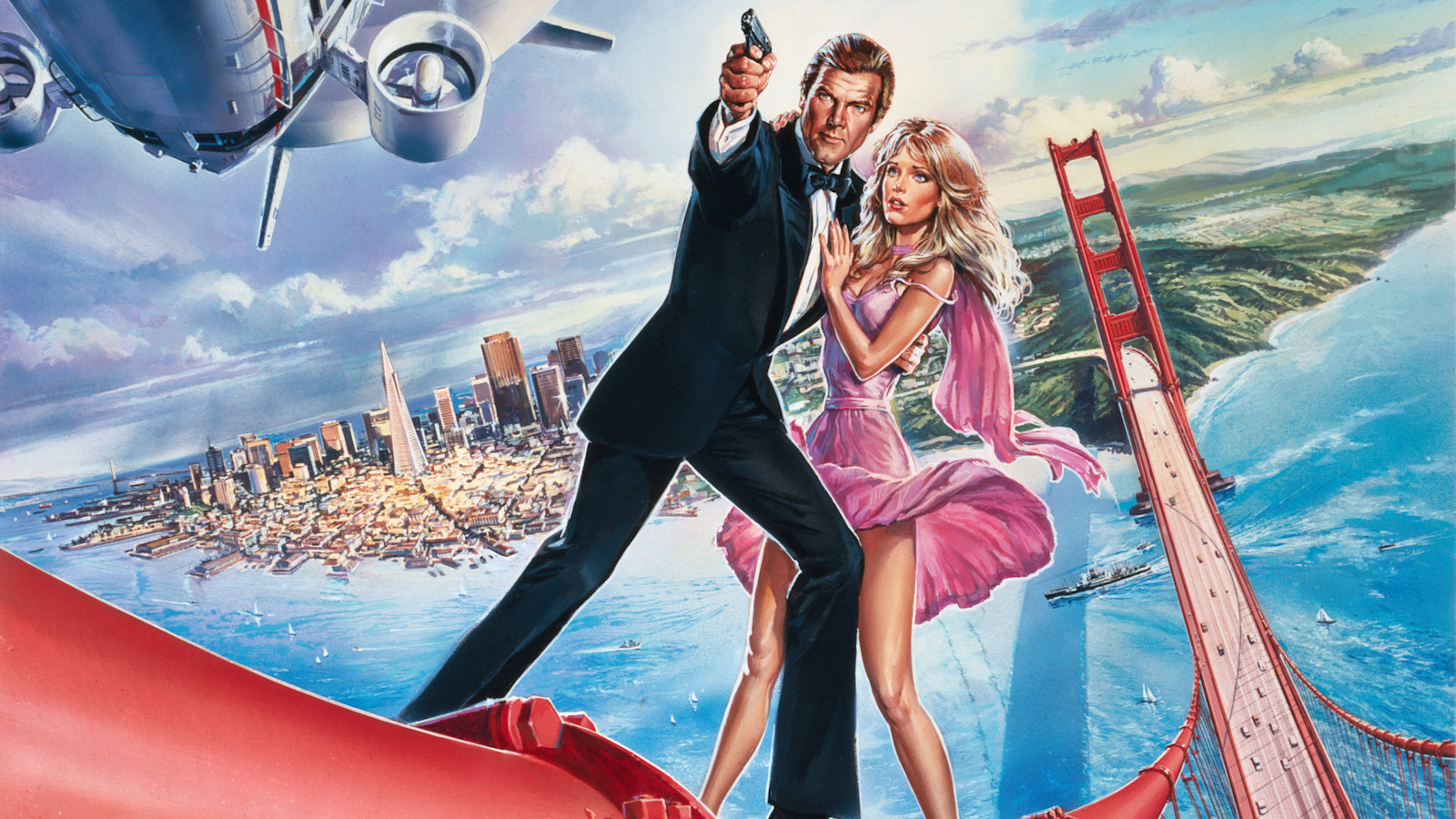A View to a Kill (1985, Dir. John Glen):
Suddenly Bond caught a trace of movement behind the men. An extra leg showed — a woman’s leg. Bond laughed out loud. The men grinned sheepishly and looked behind them. Mary Ann Russell, in a brown shirt and black jeans, came out from behind them with her hands up. One of the hands held what looked like a .22 target pistol. She brought her hands down and tucked the pistol into the top of her jeans. She came up to Bond. She said anxiously: ‘You won’t blame anybody, will you? I just wouldn’t let them leave this morning without me.’ Her eyes pleaded. ‘Rather lucky I did come, really. I mean, I just happened to get to you first. No one wanted to shoot for fear of hitting you.’
Bond smiled into her eyes. He said: ‘If you hadn’t come, I’d have had to break that dinner date.’ He turned back to the men, his voice business-like. ‘All right. One of you take the motor bike and report the gist of this to Colonel Schreiber. Say we’re waiting for his team before we take a look at the hide-out. ‘
Bond took the girl by the arm. He said: ‘Come over here. I want to show you a bird’s nest.’
‘Is that an order?’
‘Yes.’
— Ian Fleming, “From a View to a Kill”
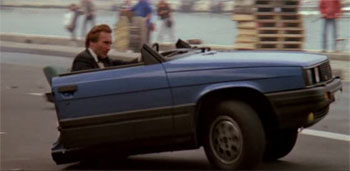 Early in A View to a Kill, James Bond (Roger Moore) commandeers a taxi in hot pursuit of a villain. Within seconds the roof and then the back half of the taxi are sheared off by collisions, and yet Bond continues the chase, the front half of the vehicle dragging itself forwards like roadkill taking its last breath. As it is with the car, so it is with the movie.
Early in A View to a Kill, James Bond (Roger Moore) commandeers a taxi in hot pursuit of a villain. Within seconds the roof and then the back half of the taxi are sheared off by collisions, and yet Bond continues the chase, the front half of the vehicle dragging itself forwards like roadkill taking its last breath. As it is with the car, so it is with the movie.
It’s not a huge surprise that A View to a Kill finds the Bond machine sputtering — and maybe audiences had an inkling something like this was coming based on the previous few Bond movies, which had struggled for consistency. In any case, the writing was on the wall. By the mid-80s, franchise filmmaking had hit a peak of sorts; Star Trek, Star Wars, Indiana Jones, Back to the Future, and a host of other films by younger, fresher minds were making hay at the box office. Meanwhile, the old warhorse Bond was plodding on in “Carry On” style, trotting along the same tracks it had followed for the last two decades. At this point, Ian Fleming’s work was an afterthought: the title of A View to a Kill was stolen from a Fleming short story, but apart from its French countryside locale, nothing else of note was imported. Instead, the movie’s concept was a retreat to those beautiful days of Goldfinger, when the bad guys were fabulously wealthy maniacs, and everything could be boiled down to halting a countdown to nuclear slaughter. Substitute Silicon Valley for Fort Knox and the world’s microchip market for the world’s gold standard, and the villain’s plot is virtually the same in both films.
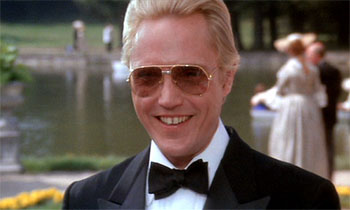 As usual, the filmmakers attempt to liven up these clichés with a few references to the current cultural climate. A View to a Kill could be called the first “New Wave” Bond: the plot at least acknowledges that the world now runs on computers. Duran Duran, the band of the moment, struts away on the theme tune, and the role of the film’s baddie, Max Zorin, was initially offered to David Bowie (who turned it down because he “didn’t want to spend five months watching my stunt double fall off cliffs”) and that cyberpunk legend Rutger Hauer. Eventually Christopher Walken, in an odd bit of casting, got the part. Bleached in platinum blonde, cackling in his Queens accent, he’s as far from Eurotrash as you can get, which is especially puzzling since Zorin is supposed to be a European industrialist who is the product of Nazi genetic experiments. Still, he’s one of the movie’s few lively elements.
As usual, the filmmakers attempt to liven up these clichés with a few references to the current cultural climate. A View to a Kill could be called the first “New Wave” Bond: the plot at least acknowledges that the world now runs on computers. Duran Duran, the band of the moment, struts away on the theme tune, and the role of the film’s baddie, Max Zorin, was initially offered to David Bowie (who turned it down because he “didn’t want to spend five months watching my stunt double fall off cliffs”) and that cyberpunk legend Rutger Hauer. Eventually Christopher Walken, in an odd bit of casting, got the part. Bleached in platinum blonde, cackling in his Queens accent, he’s as far from Eurotrash as you can get, which is especially puzzling since Zorin is supposed to be a European industrialist who is the product of Nazi genetic experiments. Still, he’s one of the movie’s few lively elements.
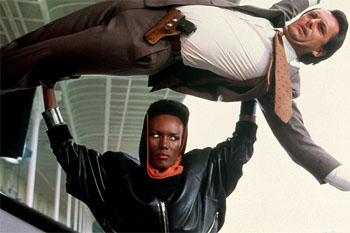 Speaking of New Wave, what could be more ’80s than Grace Jones? As Zorin’s sidekick May Day, she’s fearsome in more ways than one — when she beds down with Roger Moore you have the distinct impression that she might tear him in half — and visually, she makes quite a statement. Too bad the film never truly allows her to get her evil on, and saddles her with redemption for the finale. On the old-school side of the spectrum, the filmmakers throw in Mr. Steed himself, Patrick Macnee, as 007’s sidekick; in the annals of Bond film history, there is nothing quite so preposterous, or sad, as seeing the 56-year old Moore and the 63-year old Macnee punch out burly thugs.
Speaking of New Wave, what could be more ’80s than Grace Jones? As Zorin’s sidekick May Day, she’s fearsome in more ways than one — when she beds down with Roger Moore you have the distinct impression that she might tear him in half — and visually, she makes quite a statement. Too bad the film never truly allows her to get her evil on, and saddles her with redemption for the finale. On the old-school side of the spectrum, the filmmakers throw in Mr. Steed himself, Patrick Macnee, as 007’s sidekick; in the annals of Bond film history, there is nothing quite so preposterous, or sad, as seeing the 56-year old Moore and the 63-year old Macnee punch out burly thugs.
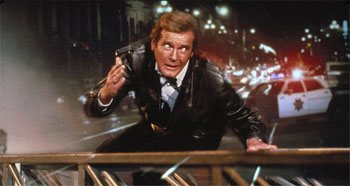 A View to a Kill is a film of several firsts, most of them regrettable. Octopussy had a Tarzan yell as our hero swings away from trouble; this movie’s bit of burlesque has Bond out-snowboarding the Soviets while a Beach Boys cover band croons “California Girls” on the soundtrack. May Day takes a jump off the top of the Eiffel Tower in what would be a breathtaking moment — if the diving board perched at the top of the tower weren’t so clearly visible in the shot. The obligatory car chase is located in San Francisco this time, but lest you have visions of Bullitt dancing in your head, the filmmakers go Keystone Capers with lumbering fire trucks and even more lumbering blue screen effects for every close-up shot of Moore. And just in case you were wondering if James Bond can cook quiche, this film demonstrates: yes, he can. We can all agree that there’s no need for us to witness it, though.
A View to a Kill is a film of several firsts, most of them regrettable. Octopussy had a Tarzan yell as our hero swings away from trouble; this movie’s bit of burlesque has Bond out-snowboarding the Soviets while a Beach Boys cover band croons “California Girls” on the soundtrack. May Day takes a jump off the top of the Eiffel Tower in what would be a breathtaking moment — if the diving board perched at the top of the tower weren’t so clearly visible in the shot. The obligatory car chase is located in San Francisco this time, but lest you have visions of Bullitt dancing in your head, the filmmakers go Keystone Capers with lumbering fire trucks and even more lumbering blue screen effects for every close-up shot of Moore. And just in case you were wondering if James Bond can cook quiche, this film demonstrates: yes, he can. We can all agree that there’s no need for us to witness it, though.
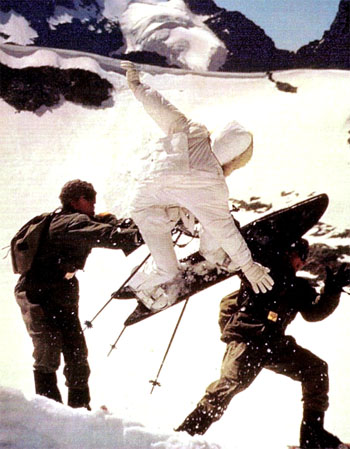 With the same creative team locked into their third Bond film in a row, it’s clear that inspiration has run dry. Dithering about from one location to the next, the film doesn’t have the all-over-the-place zaniness of Octopussy, but it doesn’t have anything of interest to compensate. As noted previously, director John Glen is a professional when it comes to shooting action; when it comes to everything else, he’s indifferent at best. (An early dialogue scene between Bond and a Zorin henchman (Patrick Bauchau) is astounding in its amateurishness — it’s clear the latter is having trouble remembering his lines, and yet the take is used in the final cut.) As with any Bond film, a few moments stand out: a steeplechase showdown between Bond and Zorin shows off some dandy stuntwork, saucy Fiona Fullerton makes the most of her all-too brief appearance as KGB agent Pola Ivanova, Moore delivers a few worthy zingers (when Macnee reminds him to stop leering at the ladies, he responds, “On a mission, I am expected to sacrifice myself”), and the final melee atop the Golden Gate Bridge is suitably vertiginous. The better Bond movies cluster moments like these together in something resembling a progression: in A View to a Kill, they’re brief mirages in the desert.
With the same creative team locked into their third Bond film in a row, it’s clear that inspiration has run dry. Dithering about from one location to the next, the film doesn’t have the all-over-the-place zaniness of Octopussy, but it doesn’t have anything of interest to compensate. As noted previously, director John Glen is a professional when it comes to shooting action; when it comes to everything else, he’s indifferent at best. (An early dialogue scene between Bond and a Zorin henchman (Patrick Bauchau) is astounding in its amateurishness — it’s clear the latter is having trouble remembering his lines, and yet the take is used in the final cut.) As with any Bond film, a few moments stand out: a steeplechase showdown between Bond and Zorin shows off some dandy stuntwork, saucy Fiona Fullerton makes the most of her all-too brief appearance as KGB agent Pola Ivanova, Moore delivers a few worthy zingers (when Macnee reminds him to stop leering at the ladies, he responds, “On a mission, I am expected to sacrifice myself”), and the final melee atop the Golden Gate Bridge is suitably vertiginous. The better Bond movies cluster moments like these together in something resembling a progression: in A View to a Kill, they’re brief mirages in the desert.
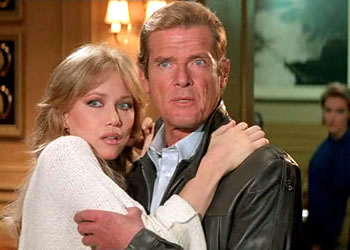 For the rest of the film’s running time, we’re divided between scorn and sorrow. The scorn is for characters like Tanya Roberts’ Stacey Sutton, who might be the ditziest, shriekiest Bond heroine of them all. (At the very least, she sets a record for the number of times a woman screams “James!” in a Bond film.) Supposedly a brainy geologist, she ranks up there with Denise Richards (The World Is Not Enough) as the most incongruous casting in franchise history. By the time a lumbering airship sneaks up on her from behind (successfully too), the only sane response is to throw up your hands. We also have Roberts to thank for a time-honored tradition in Bond propaganda: every time we’re subjected to the usual hoo-hah that the latest Bond girl is stronger and more independent than her forbears, we know who they’re referring to.
For the rest of the film’s running time, we’re divided between scorn and sorrow. The scorn is for characters like Tanya Roberts’ Stacey Sutton, who might be the ditziest, shriekiest Bond heroine of them all. (At the very least, she sets a record for the number of times a woman screams “James!” in a Bond film.) Supposedly a brainy geologist, she ranks up there with Denise Richards (The World Is Not Enough) as the most incongruous casting in franchise history. By the time a lumbering airship sneaks up on her from behind (successfully too), the only sane response is to throw up your hands. We also have Roberts to thank for a time-honored tradition in Bond propaganda: every time we’re subjected to the usual hoo-hah that the latest Bond girl is stronger and more independent than her forbears, we know who they’re referring to.
 The sorrow of this movie, of course, is watching Roger Moore in his last go-round as Bond, trudging in undignified fashion towards the exit like a former heavyweight champion who stuck around for a few fights too long. As he waddles along, the mind still willing but the body weak, one can’t help but feel a bit of sympathy, as well as an awareness of our own mortality. Other Bonds (if you don’t count Never Say Never Again) have left the role before the extra pounds and wrinkles took their toll, preserving our image of Bond as eternally young and proficient — not so with Moore, who was not so much a perpetrator as much as a victim of the Bond team’s reluctance to change things up. Stormy times lay ahead for the franchise: A View to a Kill would under-perform at the box office, and soon we would be reading headlines about Remington Steele, and then an under-the-radar Shakespearean heartthrob, taking on the lead role. But for the moment, we are left with Roger Moore’s professionalism, more touching than ever. He gives A View to a Kill a poignance that the rest of the film doesn’t deserve.
The sorrow of this movie, of course, is watching Roger Moore in his last go-round as Bond, trudging in undignified fashion towards the exit like a former heavyweight champion who stuck around for a few fights too long. As he waddles along, the mind still willing but the body weak, one can’t help but feel a bit of sympathy, as well as an awareness of our own mortality. Other Bonds (if you don’t count Never Say Never Again) have left the role before the extra pounds and wrinkles took their toll, preserving our image of Bond as eternally young and proficient — not so with Moore, who was not so much a perpetrator as much as a victim of the Bond team’s reluctance to change things up. Stormy times lay ahead for the franchise: A View to a Kill would under-perform at the box office, and soon we would be reading headlines about Remington Steele, and then an under-the-radar Shakespearean heartthrob, taking on the lead role. But for the moment, we are left with Roger Moore’s professionalism, more touching than ever. He gives A View to a Kill a poignance that the rest of the film doesn’t deserve.

